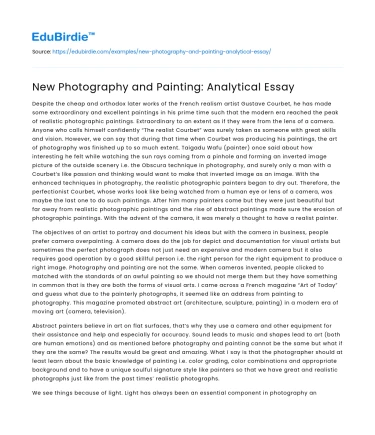Introduction
In the realm of visual arts, photography and painting have long been distinct disciplines, each with its unique methodologies and aesthetic values. However, with the advent of new technologies and evolving artistic paradigms, the boundaries between these two art forms have increasingly blurred. This convergence has prompted a re-evaluation of traditional definitions and an exploration of the ways in which photography and painting inform and enhance each other in contemporary contexts. As artists experiment with digital tools and mixed media, they are redefining the potential of visual expression. This essay examines the dynamic interplay between new photography and painting, focusing on how these media interact to create innovative art forms. By analyzing specific examples, such as David Hockney's digital paintings and Gerhard Richter's photorealistic works, the essay will argue that this intersection challenges conventional art hierarchies and expands the possibilities for artistic creation.
Technological Influence on Artistic Practices
The influence of technology on contemporary art practices has been profound, particularly in the fields of photography and painting. Digital tools and software have transformed traditional techniques, enabling artists to merge these two media in unprecedented ways. For instance, the use of computer programs like Adobe Photoshop allows artists to manipulate photographic images, applying painterly effects and textures that were once exclusive to canvas. This technological convergence is exemplified in the works of David Hockney, who has embraced digital painting as a means of exploring new visual languages. Hockney's iPad drawings, which he describes as "painting with light," illustrate how digital technology can extend the painter's palette beyond physical materials.
Save your time!
We can take care of your essay
- Proper editing and formatting
- Free revision, title page, and bibliography
- Flexible prices and money-back guarantee
Moreover, the integration of photographic elements into painting has led to the emergence of photorealism, a genre that blurs the distinction between photograph and painting. Gerhard Richter, a leading figure in this movement, employs photographic references in his paintings to question the nature of representation and reality. Richter's technique of blurring the painted image challenges the viewer's perception, creating a visual experience that is both photographic and painterly. As noted by art critic Robert Storr, Richter's work "undermines the reliability of photographic images while simultaneously reaffirming their importance as a source of visual truth."
Such examples demonstrate how technology has facilitated the fusion of photography and painting, producing artworks that defy traditional categorizations. However, this technological influence has also sparked debates about authenticity and originality in art. Critics argue that digital manipulation can undermine the artist's hand, yet proponents contend that it offers new opportunities for creative expression. Ultimately, the integration of technology in art highlights the evolving nature of artistic practices and the ongoing dialogue between tradition and innovation.
Artistic Innovation Through Hybridization
The hybridization of photography and painting has led to significant artistic innovation, as artists experiment with blending these media to create new forms of expression. This process of hybridization is evident in the works of contemporary artists who incorporate photographic techniques into their painting practice. For example, the American artist Chuck Close is renowned for his large-scale portraits that combine photographic precision with painterly abstraction. Close's method involves gridding a photograph and translating each section into a painted square, resulting in a composite image that challenges the boundaries between the photographic and the painterly.
In addition to individual artists, collaborative projects have further explored the intersection of photography and painting. The collaborative series "Camera Obscura" by painters and photographers captures the essence of both mediums, where images are projected onto canvas and then painted over, creating a dialogue between the two disciplines. This approach not only expands the artist's toolkit but also invites viewers to engage with art on multiple levels, appreciating the complexities of perception and interpretation.
Despite the innovative potential of hybridization, it also poses challenges to conventional art discourse. Traditional art hierarchies often prioritize painting over photography, viewing the former as a higher form of art due to its historical significance and perceived technical difficulty. However, as artists continue to merge these media, they challenge these hierarchies, emphasizing the value of interdisciplinary approaches. As noted by art historian Rosalind Krauss, "the most exciting art today is that which refuses to be categorized, that which exists in the interstices of established disciplines."
By embracing hybridization, artists are not only expanding the boundaries of visual art but also questioning the very definitions of what constitutes art. This shift reflects a broader trend in contemporary culture towards interdisciplinarity and the dissolution of rigid boundaries, ultimately enriching the artistic landscape with diverse and innovative forms of expression.
Conclusion
In conclusion, the intersection of new photography and painting represents a dynamic and fertile ground for artistic exploration. As the boundaries between these media continue to dissolve, artists are empowered to experiment with new forms of expression that challenge traditional art hierarchies and expand the possibilities of visual representation. Through the integration of technology and the process of hybridization, contemporary artists such as David Hockney, Gerhard Richter, and Chuck Close are redefining the potential of their craft, creating works that are both innovative and reflective of the complexities of modern life.
While debates regarding authenticity and originality persist, the convergence of photography and painting ultimately enriches the artistic discourse, offering new perspectives on the nature of art itself. As visual artists continue to navigate this evolving landscape, they contribute to a vibrant and diverse artistic tradition that celebrates the interplay between different media. This ongoing dialogue not only enhances our understanding of art but also invites us to reconsider the ways in which we perceive and engage with the world around us.






 Stuck on your essay?
Stuck on your essay?

